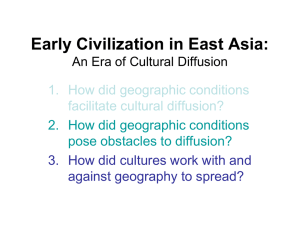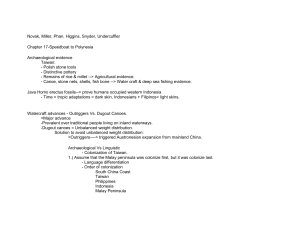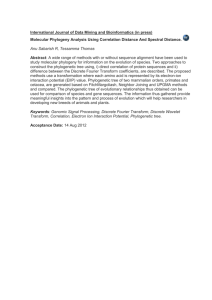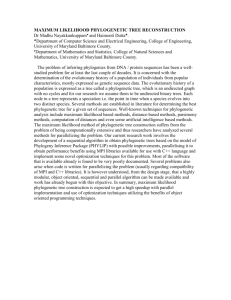29 June 2000
advertisement
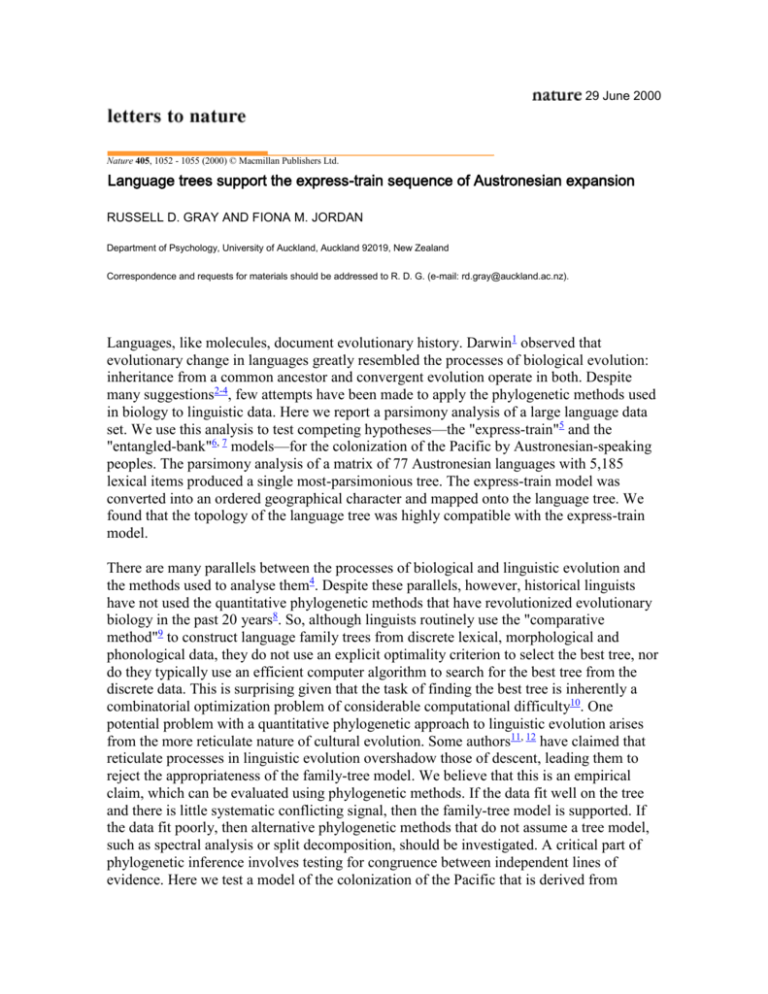
29 June 2000 Nature 405, 1052 - 1055 (2000) © Macmillan Publishers Ltd. Language trees support the express-train sequence of Austronesian expansion RUSSELL D. GRAY AND FIONA M. JORDAN Department of Psychology, University of Auckland, Auckland 92019, New Zealand Correspondence and requests for materials should be addressed to R. D. G. (e-mail: rd.gray@auckland.ac.nz). Languages, like molecules, document evolutionary history. Darwin1 observed that evolutionary change in languages greatly resembled the processes of biological evolution: inheritance from a common ancestor and convergent evolution operate in both. Despite many suggestions2-4, few attempts have been made to apply the phylogenetic methods used in biology to linguistic data. Here we report a parsimony analysis of a large language data set. We use this analysis to test competing hypotheses—the "express-train"5 and the "entangled-bank"6, 7 models—for the colonization of the Pacific by Austronesian-speaking peoples. The parsimony analysis of a matrix of 77 Austronesian languages with 5,185 lexical items produced a single most-parsimonious tree. The express-train model was converted into an ordered geographical character and mapped onto the language tree. We found that the topology of the language tree was highly compatible with the express-train model. There are many parallels between the processes of biological and linguistic evolution and the methods used to analyse them4. Despite these parallels, however, historical linguists have not used the quantitative phylogenetic methods that have revolutionized evolutionary biology in the past 20 years8. So, although linguists routinely use the "comparative method"9 to construct language family trees from discrete lexical, morphological and phonological data, they do not use an explicit optimality criterion to select the best tree, nor do they typically use an efficient computer algorithm to search for the best tree from the discrete data. This is surprising given that the task of finding the best tree is inherently a combinatorial optimization problem of considerable computational difficulty10. One potential problem with a quantitative phylogenetic approach to linguistic evolution arises from the more reticulate nature of cultural evolution. Some authors11, 12 have claimed that reticulate processes in linguistic evolution overshadow those of descent, leading them to reject the appropriateness of the family-tree model. We believe that this is an empirical claim, which can be evaluated using phylogenetic methods. If the data fit well on the tree and there is little systematic conflicting signal, then the family-tree model is supported. If the data fit poorly, then alternative phylogenetic methods that do not assume a tree model, such as spectral analysis or split decomposition, should be investigated. A critical part of phylogenetic inference involves testing for congruence between independent lines of evidence. Here we test a model of the colonization of the Pacific that is derived from predominantly archaeological data by quantitatively examining its fit with a parsimony tree of Austronesian languages. Prehistoric human colonization in the Pacific happened in two phases. Initially, Pleistocene hunter–gatherer expansions from Island Southeast Asia through New Guinea reached the Bismarck archipelago by 33,000 BP and the Papuan-speaking descendants of these people are dispersed throughout New Guinea and parts of Island Melanesia13. The second colonization wave of Austronesian language speakers involved a diaspora of Neolithic farming peoples out of south China and Taiwan around 6,000 BP13-15. According to the 'express train to Polynesia' model, the Austronesian expansion from Taiwan was extremely rapid, taking roughly 2,100 years to reach the edges of western Polynesia—a distance of 10,000 kilometres. Converging evidence from archaeology and molecular anthropology supports a rapid and relatively encapsulated dispersal of the Austronesian speakers throughout the Pacific13, 16-18 (Fig. 1); however, there is some dispute about the exact degree of interaction with earlier Melanesian settlers, the rate at which the migration occurred and the extent and location of any colonization pauses19. In broad terms, most Pacific scholars seem to favour the express-train model, but others have argued that the ancestral Polynesians derive from an older Melanesian "matrix"7, 20. The latter authors stress that a phylogenetic, colonization-focused perspective obscures the high degree of prehistoric contact and inter-relationships amongst Pacific people; we use Terrell's phrase6—the entangled-bank model—to represent this. These two models are not mutually exclusive, but are best characterized as two ends of a continuum of modes of human prehistory, with a pure tree at one end and a maximally connected network at the other. The issues surrounding the settlement of the Pacific are thus a microcosm of the general debate about whether human cultural evolution can be appropriately represented as a tree. Figure 1 The express train to Polynesia model of the Austronesian colonization of the Pacific (adapted from refs 5 and 22). Full legend High resolution image and legend (41k) We tested one aspect of the express-train model, the colonization sequence, in the way that biologists test hypotheses about the sequence of events in biological evolution. We constructed a tree and then mapped the trait onto the tree to see whether the inferred sequence of changes fits a particular scheme21. Figure 2 shows how a simple colonization scheme can be tested by mapping geography onto an independent tree. We grouped languages according to Diamond's archaeological/geographical stations5, 22. Using character-state functions in the program MacClade23, we assigned each station a character state from 0 to 9. The states were ordered in a character-state tree to fit the sequence proposed by the express-train model. For example, in Fig. 1 the Taiwanese languages were grouped as state 1, the Remote Oceanic languages as state 8; this means a change from state 1 to 8 would require five steps (according to the model presented in Fig. 1). By mapping these character states onto the most-parsimonious language tree (Fig. 3), we were able to evaluate the express-train model in a quantitative manner. If the language tree fits the express-train model well, then the character-state tree should fit well onto our obtained tree. The shortest possible tree length required to optimize the character-state tree onto the language tree was nine (that is, the number of character states minus one). When the character-state tree was mapped onto the optimal tree, we obtained a tree length of 13. To assess the statistical significance of the fit, we randomly shuffled the character states between the 77 languages 200 times23. This gave us a null distribution of tree lengths with a mean tree length of 48.9 steps (s.d. 1.98, range 43–53). This indicates that the express-train character-state tree fits the language tree with significantly fewer steps than would occur by chance. In fact, the obtained fit was very close to the shortest possible length (nine), indicating that the express-train model fits the language tree exceptionally well. Figure 2 A phylogenetic approach to testing a colonization sequence. Full legend High resolution image and legend (39k) Figure 3 Phylogenetic tree of 77 Austronesian languages. Full legend High resolution image and legend (93k) By definition, an entangled-bank model cannot be represented by a character-state tree; however, we can assess whether the language data support the entangled-bank model by examining the topology of the tree. While advocates of this model make no predictions about the likely shape of a language tree under an entangled-bank conception, they argue that large-scale migration patterns in languages are obscured by culture contact7. Consequently, they might predict a layered, 'candelabra-like' tree that emphasizes regional contact. In contrast, an (archaeologically) quick colonizing wave from Island Southeast Asia through the Pacific to Polynesia should produce a tree topology that is 'chain-like' (see Fig. 3). Proponents of the entangled-bank model argue that culture, language and biology 'combine and recombine' in such complex interactions that patterns of language relationships may tell us very little about the history of language speakers7. In this case, the tree should merely reflect geographical proximity. Our tree, however, shows several cases where the relationships fit the historical sequences implied by the express-train model but conflict with geographical proximity (see Fig. 3). Although we reject the specific features of the entangled-bank model, we do not claim that Austronesian cultural history is totally tree-like. The consistency index (a measure of the fit of the lexical data on the tree) is only 0.25. This value is not substantially lower than would be expected for equivalently sized morphological and molecular data sets24 in which hybridization is uncommon. Although it is probable that much of the poor fit in the lexical data is due to the loss of cultural or linguistic features15, 25, archaeological26 and genetic27 evidence do indicate that population interaction and 'borrowing' are likely to have occurred even between far-flung archipelagoes. A way of approaching the issue of borrowing is to examine languages whose placement conflicts with the colonization scheme. For example, Buli and Numfor are grouped inside the Oceanic language group on our tree, whereas the express-train model places these south Halmahera/west New Guinea languages outside the Oceanic group. Similarly, Chamorro and Palau—languages whose closest relationships are most likely with the Philippines28—are grouped with the Oceanic languages. In both these cases, borrowing is a likely cause of the incongruence between the express-train model and our tree. More detailed evidence for specific patterns of reticulation is evaluated elsewhere (F.M.J. and R.D.G, manuscript in preparation). The patterns apparent in linguistic relationships are integrally tied to the movements, contacts and activities of language speakers. Our preliminary investigations have shown that a phylogenetic approach to languages offers the ability to test hypotheses about human prehistory. In biology, phylogenetic methods have become invaluable tools for investigating patterns and processes in evolution. In the future, phylogenetic methods may provide a common methodology and analytic framework to integrate data from ethnography, archaeology, linguistics and genetics. This is an important step towards a unified approach to biological and cultural evolution. Methods Data were taken from Blust's Austronesian Comparative Dictionary (R. Blust, personal communication). This is a continuing project to compile comparative lexical data from the largest language family in the world. Currently, the dictionary is 25% complete and comprises 5,185 lexical items across 191 languages. Each lexical item has a set of cognate terms listed with the languages in which they appear. To ensure that there was sufficient information in the data set for phylogenetic analysis, we cut the number of languages from 191 to 68 by using a criterion of 150 or more appearances in a cognate set. An additional nine languages were then added to provide a balanced representation of the principal Austronesian language subgroups, giving us 77 languages in total. The presence of a language in a cognate set was coded as '1' in a matrix of 77 languages 5,185 lexical items. If a language was not present in a particular cognate set, that language was coded as '0' for that item in the matrix. Linguistic15, 28, archaeological13 and genetic16, 18 evidence agrees that Taiwan is the most likely Austronesian homeland, and so the two Taiwanese languages (Amis and Paiwan) were used to root the tree. We used PAUP* 4.0d65 (ref. 29) to find the set of most-parsimonious trees. To maximize the chance of finding optimal trees, 1,200 random addition sequences and tree bisection–reconnection branch swapping were used. Characters were typed as easy loss (5:1 ratio) on the assumption that independent losses of lexical items were more likely than independent gains. Similar assumptions about character coding have been used for complex behavioural characters30, and linguistic features (such as phonemes) have been shown to be lost in a west-to-east direction across the Pacific25. Other easy loss codings and equally weighted parsimony produced similar results (R.D.G. and F.M.J., manuscript in preparation). The search found one shortest tree of 52,129 steps with a consistency index of 0.25. The linguistic data set contained significant phylogenetic signal (treelength skewness index g1 = -0.505 calculated from 100,000 random trees). Received 6 January 2000; accepted 28 April 2000 References 1. Darwin, C. The Descent of Man, and Selection in Relation to Sex (Oxford Univ. Press, Oxford, 1871). 2. Kirch, P. V. & Green, R. C. History, phylogeny, and evolution in Polynesia. Curr. Anthropol. 28, 431-456 (1987). | Article | ISI | 3. Mace, R. & Pagel, M. The comparative method in anthropology. Curr. Anthropol. 35, 549-564 (1994). | Article | ISI | 4. Ruvolo, M. in Biological Metaphor and Cladistic Classification: An Interdisciplinary Perspective (eds Hoenigswald, H. M. & Wiener, L. F.) 193-216 (Univ. Pennsylvania Press, Pennsylvania, 1987). 5. Diamond, J. M. Express train to Polynesia. Nature 336, 307-308 (1988). | ISI | 6. Terrell, J. History as a family tree, history as an entangled bank: Constructing images and interpretations of prehistory in the South Pacific. Antiquity 62, 642-657 (1988). | ISI | 7. Terrell, J., Hunt, T. L. & Gosden, C. The dimensions of social life in the Pacific. Curr. Anthropol. 38, 155-195 (1997). | Article | ISI | 8. Hillis, D. M., Huelsenbeck, J. P. & Cunningham, C. W. Application and accuracy of molecular phylogenies. Science 264, 671-676 (1994). | PubMed | ISI | 9. Crowley, T. An Introduction to Historical Linguistics 3rd edn (Oxford Univ. Press, Auckland, 1997). 10. Warnow, T. Mathematical approaches to comparative linguistics. Proc. Natl Acad. Sci. USA 94, 6585-6590 (1997). | Article | PubMed | ISI | 11. Bateman, R. et al. Speaking of forked tongues. Curr. Anthropol. 31, 1-24 (1990). | Article | ISI | 12. Moore, J. H. Putting anthropology back together again: The ethnogenetic critique of cladistic theory. Am. Anthropol. 96, 925-948 (1994). 13. Bellwood, P. The Prehistory of the Indo-Malaysian Archipelago 2nd edn (Univ. Hawaii Press, Honolulu, 1997). 14. Bellwood, P. The Austronesian dispersal and the origin of languages. Sci. Am. 265, 88-93 (1991). | ISI | 15. Blust, R. The prehistory of the Austronesian speaking peoples: a view from language. J. World Prehist. 9, 453-510 (1995). | ISI | 16. Melton, T. et al. Polynesian genetic affinities with Southeast Asian populations as identified by mtDNA analysis. Am. J. Hum. Genet. 57, 403-414 (1995). | PubMed | ISI | 17. Green, R. C. Integrating historical linguistics with archaeology: Insights from research in Remote Oceania. Bull. Indo-Pacific Prehist. Ass. 18, 3-16 (1999). 18. Lum, J. K. & Cann, R. L. mtDNA and language support a common origin of Micronesians and Polynesians in Island Southest Asia. Am. J. Phys. Anthropol. 105, 109-119 (1998). | Article | PubMed | ISI | 19. Kirch, P. V. The Lapita Peoples (Blackwell, Cambridge, 1997). 20. Terrell, J. Prehistory in the Pacific Islands: A Study of Variation in Language, Customs, and Human Biology (Cambridge Univ. Press, Cambridge, 1986). 21. Martin, A. Hammerhead shark origins. Nature 364, 494 (1993). | ISI | 22. Diamond, J. M. Guns, Germs and Steel (Jonathan Cape, London, 1997). 23. Maddison, W. P. & Maddison, D. R. MacClade: Analysis of Phylogeny and Character Variation Version 3.05. (Sinauer Associates, Massachusetts, 1992). 24. Sanderson, M. J. & Donoghue, M. J. Patterns of variation in levels of homoplasy. Evolution 43, 1781-1795 (1989). | ISI | 25. Blust, R. in Currents in Pacific Linguistics: Papers on Austronesian Languages and Ethnolinguistics in Honour of George W. Grace (ed. Blust, R.) 27-42 (Australian National Univ., Canberra, 1991). 26. Weisler, M. I. Hard evidence for prehistoric interaction in Polynesia. Curr. Anthropol. 39, 521531 (1998). | Article | ISI | 27. Matisoo-Smith, E. et al. Patterns of prehistoric human mobility in Polynesia indicated by mtDNA from the Pacific rat. Proc. Natl Acad. Sci. USA 95, 15145-15150 (1998). | Article | PubMed | ISI | 28. Ross, M. D. in Comparative Austronesian Dictionary: An Introduction to Austronesian Studies (ed. Tryon, D. T.) 27-42 (ANU, Canberra, 1994). 29. Swofford, D. L. Phylogenetic Analysis Using Parsimony (PAUP*) Version 4.0d65. (Sinauer Associates, Massachusetts, 1999). 30. Cunningham, C. W., Omland, K. E. & Oakley, T. H. Reconstructing ancestral character states: a critical reappraisal. Trends Ecol. Evol. 13, 361-366 (1998). | Article | ISI | Acknowledgements. We are grateful to R. Blust for making the Austronesian Comparative Dictionary available to us. We thank M. Corballis, R. Green and A. Rodrigo for comments on the manuscript; R. Clark for advice; and H. Tse for programming assistance.
